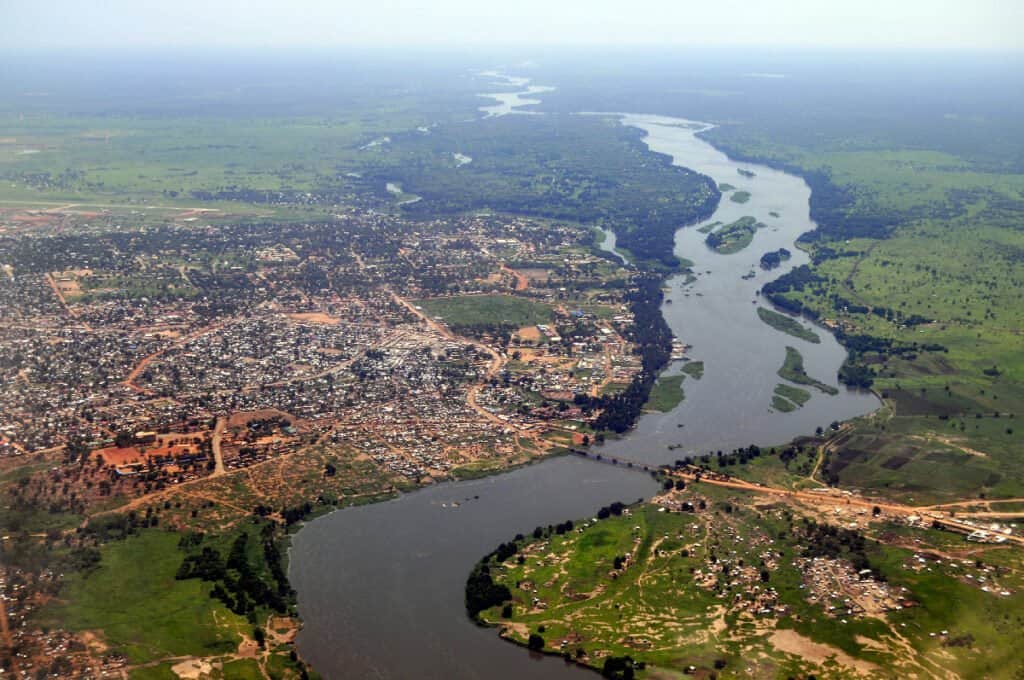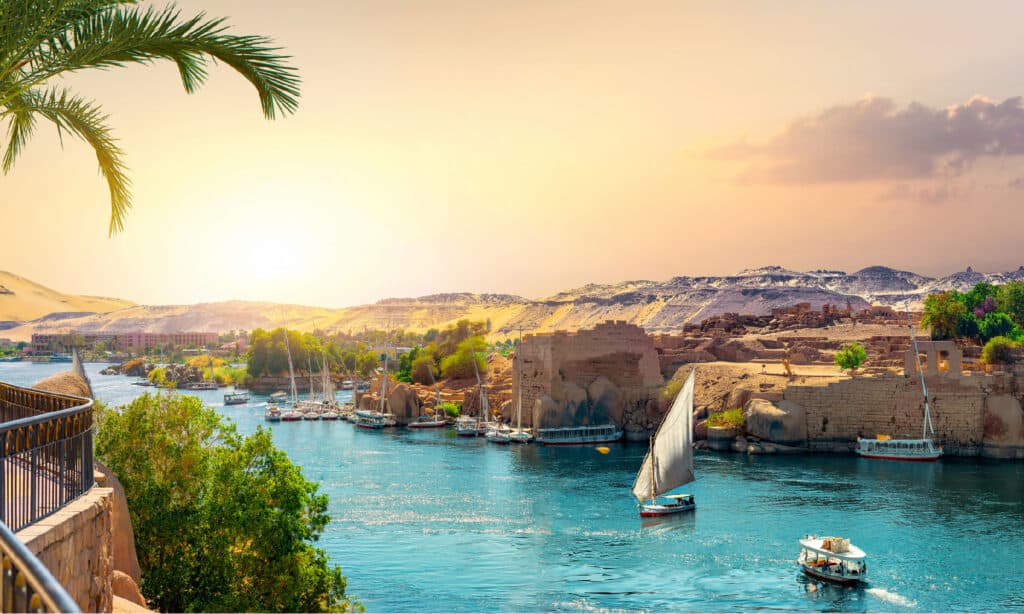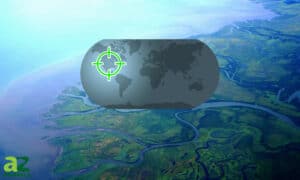How Wide is the Nile River at Its Widest Point?
From Ancient Egypt to modern times, the fertile banks of the Nile have been the home to many incredible civilizations. Wrapped up in myths and intrigue, the Nile River is an agricultural oasis and source of life to many who live in its vicinity.
How Wide is the Nile River at its Widest Point?
The Nile River is 1.7 miles wide at its widest point at Edfu, and this African giant is the second-longest river on earth. And equally impressive is that this 4,258-miles-long Nile River meanders through 11 African countries on its way to the Mediterranean Sea.
How Large is the Nile River in Volume?

iStock.com/Phototreat
The Nile River discharges 200,000 cubic feet per second at peak flow over the wet season. On average, the river’s discharge is 10.59 billion cubic feet per day. This release equals approximately 79.2 billion gallons of water daily.
As with all rivers, exact discharge measurements are complex, so scientists can only offer an estimate. However, at any given point, the discharge volume of the Nile River depends on factors including the weather, diversions, evaporation, and groundwater flow. Additionally, the river’s tributaries are the primary sources of natural variation in the flow.
According to a Dutch bilingual travel magazine, Travelling Along Rivers, the Nile takes a three-month journey from Jinja in Uganda to the Mediterranean Sea. However, this description only paints a small picture of the immense size of the Nile River.
Which Main Tributaries Supply the Nile River?
The two main tributaries feeding the Nile River are the White Nile and the Blue Nile. The White Nile begins in Equatorial East Africa, while the Blue Nile begins in Ethiopia. Both tributaries are on the western flanks of the East African Rift.
The Blue Nile contributes approximately 80 to 90% of the Nile River’s discharge, while the White Nile supplies 31% of its yearly release of water into the Mediterranean Sea.
But, the release volume of both tributaries varies considerably over the yearly cycle. While the White Nile contributes more during the drier season than the Blue Nile, the Blue Nile’s discharge can drop to a low of 4626 cubic feet per second in the drier season.
Additionally, the Atbara is a lesser tributary that contributes to the Nile River. Originating in Ethiopia, the Atbara River joins the Nile approximately 200 miles past Khartoum. However, the Atbara only flows while there is rain in Ethiopia, drying up completely in the drier seasons.
How Large is the Nile Delta?

AlexAnton/Shutterstock.com
The Nile Delta enjoys a reputation as one of the world’s largest. From its most northern to southern points, it is approximately 100 miles long. Similarly, this river delta spans 150 miles of the Egyptian coastline from Alexandria in the west to Port Said in the east.
As the Delta approaches the Mediterranean Sea, it splits into two main branches to the east and west. The branch to the east is Damietta, while the Rosetta Branch is to the west.
Incredibly, the Nile Delta reaches 40 million people along its route, half of Egypt’s population.
How Does the Nile Compare to the Congo River?
The Nile and the Congo are both dominant river systems in Africa. However, where the Nile is the longest river in Africa, the Congo is the deepest.
Another distinguishing feature is that the Congo River is also the most powerful in Africa. At certain times in the year, its discharge reaches over 1,800,000 cubic feet per second. As a result, its hydropower potential is unmatched.
In comparison, the Nile River carries far less water despite its great reach. While the Nile does not rank high in volume compared to other African rivers, its nutrient-dense waters have no parallel.
Which Animals Make the Nile River Their Home?

The Nile and its fertile riverbanks are overflowing with various animal wildlife and over 300 species of birds. Thousands of migratory water birds make their way to the Nile Delta during winter. Fish, birds, mammals, and amphibians you can expect to find living along the Nile River are:
- Gulls
- Whiskered terns
- Osprey
- Moorhen
- Blue-Winged Geese
- Rhinoceros
- Nile Monitors
- African Tigerfish
- Hippopotamuses
- Mongooses
- Wildebeests
- Baboons
- Frogs
- Turtles
- Tortoises
More sinisterly, the depth of the Nile is home to the infamous 18 to 20 feet Nile crocodile. These aggressive predators hunt other animals but have also preyed on several people living along the Nile.
Why is the Nile River Vital to Both Egypt and Sudan?

iStock.com/Givaga
Egypt and Sudan depend on the Nile River’s waters as a source of water to sustain crops. However, since rainfall is exceptionally infrequent in Egypt and Sudan, most of the year is spent in severe drought.
In ancient times, heavy yearly rainfall from Ethiopia would cause flooding and an overflowing of the banks of the Nile. When the flooding receded, it left silt and nutrient-rich soil to plant crops.
Over the last hundred years, both Egypt and Sudan have built dams and reservoirs to limit the ravages of drought on their lands. So, the Nile-fed dams and reservoirs facilitate the growth of food crops. Notably, the Nile is the primary resource for ensuring fertile agricultural land.
Not only is the Nile a source of sustenance for equatorial Africa, but it is also a means of travel and transportation of materials for building projects and endeavors.
Nile River Facts To Take Away
- The Nile River is 1.7 miles wide at its widest point at Edfu.
- The Nile River flows through eleven African countries.
- The Nile River is 4,130 miles long.
- The Nile is the second-longest river in the world.
- The Nile River discharges an average volume of 10.59 billion cubic feet daily.
- The White and Blue Nile are the two main tributaries feeding into the Nile River.
- The Nile Delta reaches 40 million people on the route.
- Egypt, Sudan, and much of equatorial Africa depend almost entirely on the Nile River as a water source.
- The Nile crocodile is a vicious predator that lives in the Nile River.
- The water of the Nile River is rich in silt and nutrients.
More from A-Z Animals
From Ancient Egypt to modern times, the fertile banks of the Nile have been the home to many incredible civilizations. Wrapped up in myths and intrigue, the Nile River is an agricultural oasis and source of life to many who live in its vicinity.
How Wide is the Nile River at its Widest Point?
The Nile River is 1.7 miles wide at its widest point at Edfu, and this African giant is the second-longest river on earth. And equally impressive is that this 4,258-miles-long Nile River meanders through 11 African countries on its way to the Mediterranean Sea.
How Large is the Nile River in Volume?

iStock.com/Phototreat
The Nile River discharges 200,000 cubic feet per second at peak flow over the wet season. On average, the river’s discharge is 10.59 billion cubic feet per day. This release equals approximately 79.2 billion gallons of water daily.
As with all rivers, exact discharge measurements are complex, so scientists can only offer an estimate. However, at any given point, the discharge volume of the Nile River depends on factors including the weather, diversions, evaporation, and groundwater flow. Additionally, the river’s tributaries are the primary sources of natural variation in the flow.
According to a Dutch bilingual travel magazine, Travelling Along Rivers, the Nile takes a three-month journey from Jinja in Uganda to the Mediterranean Sea. However, this description only paints a small picture of the immense size of the Nile River.
Which Main Tributaries Supply the Nile River?
The two main tributaries feeding the Nile River are the White Nile and the Blue Nile. The White Nile begins in Equatorial East Africa, while the Blue Nile begins in Ethiopia. Both tributaries are on the western flanks of the East African Rift.
The Blue Nile contributes approximately 80 to 90% of the Nile River’s discharge, while the White Nile supplies 31% of its yearly release of water into the Mediterranean Sea.
But, the release volume of both tributaries varies considerably over the yearly cycle. While the White Nile contributes more during the drier season than the Blue Nile, the Blue Nile’s discharge can drop to a low of 4626 cubic feet per second in the drier season.
Additionally, the Atbara is a lesser tributary that contributes to the Nile River. Originating in Ethiopia, the Atbara River joins the Nile approximately 200 miles past Khartoum. However, the Atbara only flows while there is rain in Ethiopia, drying up completely in the drier seasons.
How Large is the Nile Delta?

AlexAnton/Shutterstock.com
The Nile Delta enjoys a reputation as one of the world’s largest. From its most northern to southern points, it is approximately 100 miles long. Similarly, this river delta spans 150 miles of the Egyptian coastline from Alexandria in the west to Port Said in the east.
As the Delta approaches the Mediterranean Sea, it splits into two main branches to the east and west. The branch to the east is Damietta, while the Rosetta Branch is to the west.
Incredibly, the Nile Delta reaches 40 million people along its route, half of Egypt’s population.
How Does the Nile Compare to the Congo River?
The Nile and the Congo are both dominant river systems in Africa. However, where the Nile is the longest river in Africa, the Congo is the deepest.
Another distinguishing feature is that the Congo River is also the most powerful in Africa. At certain times in the year, its discharge reaches over 1,800,000 cubic feet per second. As a result, its hydropower potential is unmatched.
In comparison, the Nile River carries far less water despite its great reach. While the Nile does not rank high in volume compared to other African rivers, its nutrient-dense waters have no parallel.
Which Animals Make the Nile River Their Home?

The Nile and its fertile riverbanks are overflowing with various animal wildlife and over 300 species of birds. Thousands of migratory water birds make their way to the Nile Delta during winter. Fish, birds, mammals, and amphibians you can expect to find living along the Nile River are:
- Gulls
- Whiskered terns
- Osprey
- Moorhen
- Blue-Winged Geese
- Rhinoceros
- Nile Monitors
- African Tigerfish
- Hippopotamuses
- Mongooses
- Wildebeests
- Baboons
- Frogs
- Turtles
- Tortoises
More sinisterly, the depth of the Nile is home to the infamous 18 to 20 feet Nile crocodile. These aggressive predators hunt other animals but have also preyed on several people living along the Nile.
Why is the Nile River Vital to Both Egypt and Sudan?

iStock.com/Givaga
Egypt and Sudan depend on the Nile River’s waters as a source of water to sustain crops. However, since rainfall is exceptionally infrequent in Egypt and Sudan, most of the year is spent in severe drought.
In ancient times, heavy yearly rainfall from Ethiopia would cause flooding and an overflowing of the banks of the Nile. When the flooding receded, it left silt and nutrient-rich soil to plant crops.
Over the last hundred years, both Egypt and Sudan have built dams and reservoirs to limit the ravages of drought on their lands. So, the Nile-fed dams and reservoirs facilitate the growth of food crops. Notably, the Nile is the primary resource for ensuring fertile agricultural land.
Not only is the Nile a source of sustenance for equatorial Africa, but it is also a means of travel and transportation of materials for building projects and endeavors.
Nile River Facts To Take Away
- The Nile River is 1.7 miles wide at its widest point at Edfu.
- The Nile River flows through eleven African countries.
- The Nile River is 4,130 miles long.
- The Nile is the second-longest river in the world.
- The Nile River discharges an average volume of 10.59 billion cubic feet daily.
- The White and Blue Nile are the two main tributaries feeding into the Nile River.
- The Nile Delta reaches 40 million people on the route.
- Egypt, Sudan, and much of equatorial Africa depend almost entirely on the Nile River as a water source.
- The Nile crocodile is a vicious predator that lives in the Nile River.
- The water of the Nile River is rich in silt and nutrients.





